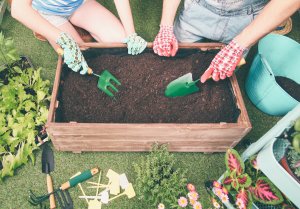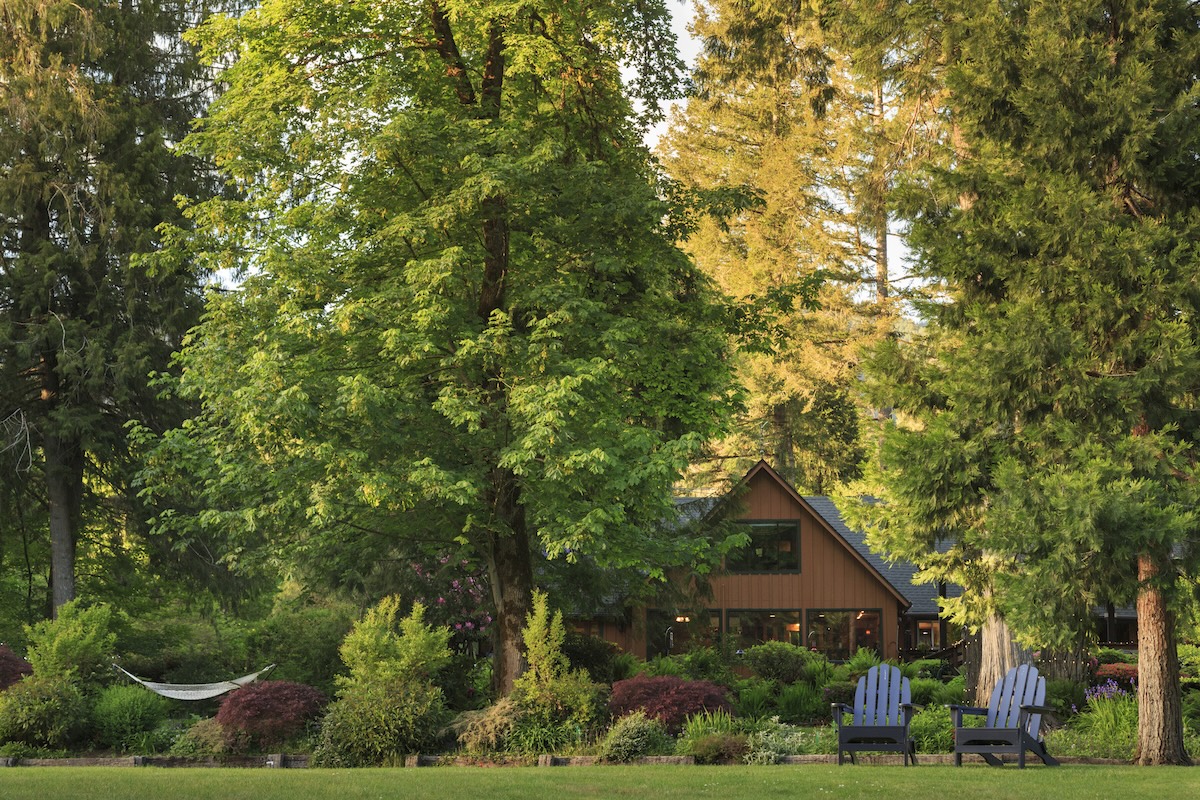

We may earn revenue from the products available on this page and participate in affiliate programs. Learn More ›
Well-tended, colorful trees can add much-needed shade, privacy, and value to your property. With global deforestation a real environmental concern, every tree planted—even just one or two in the backyard—can be a step toward improving your yard while increasing the health of our planet.
Backyard trees also provide a home for wildlife, and in many cases, perform critical functions in the healthy ecosystem of a region. Tree roots take up water that might otherwise run off and create problems down the line.
These trees are some of our longstanding favorites. They aren’t just beautiful, either—they benefit to the environment.
How to Choose Trees for Your Backyard
Adding a tree to your landscape is almost as important as choosing which puppy to bring home from the shelter. Is it a good fit? Will it get along with the others? Do you have the right setting? Will it make a big mess?
Here are some considerations to keep in mind when selecting good landscaping trees:
- Suitability for your climate
- Compatibility with your soil type
- Irrigation needs
- Property size
- Mature size of the tree
- Color
- Seasonal interest
- Potential for messes
1. Dogwood (Cornus)
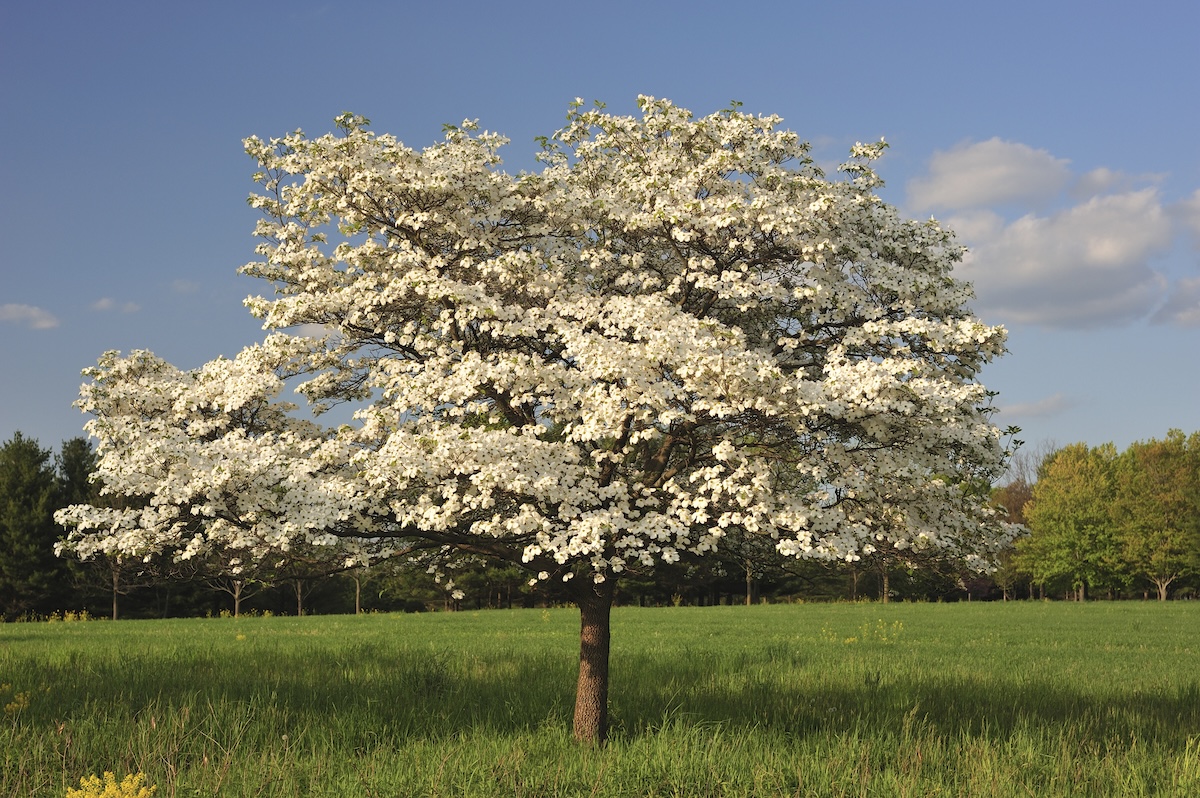
USDA hardiness zones: 5 to 9
Size: 10–15 feet wide; typically around 30 feet tall, though some varieties can grow up to 40 feet tall
A dogwood tree brings beauty and interest to a backyard or front yard all year long. It flowers during spring in a profusion of white, pink, or red blossoms, and then features a lush and compact canopy of foliage in the summer.
Most varieties display red foliage in the fall before dropping leaves to show off attractive branching in the winter. Most dogwoods prefer some shade, though some will tolerate full sun. They prefer slightly acidic, well-drained soil, and while you’ll find numerous varieties of dogwood to choose from, most are not drought-tolerant.
2. Saucer Magnolia (Magnolia x soulangeana)
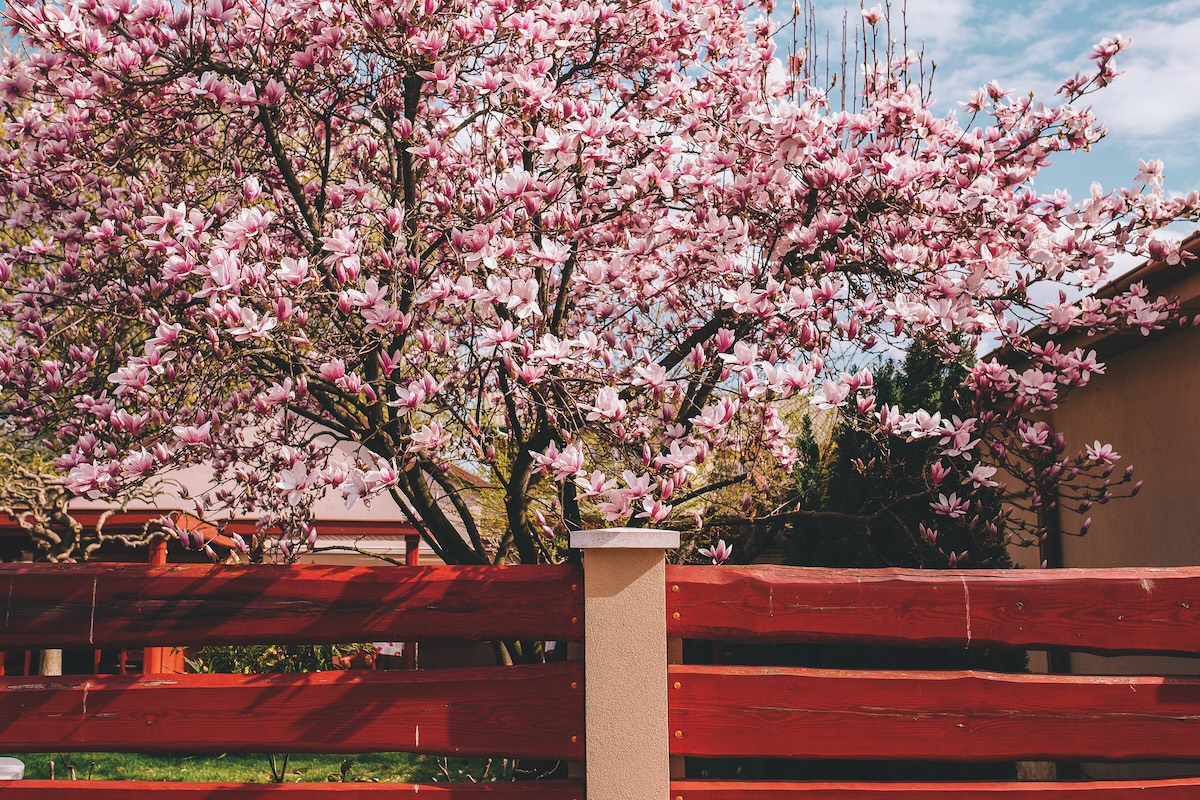
USDA hardiness zones: 4 to 9
Size: 20–30 feet tall and wide
Emblazoned with 5- to 10-inch pinkish-purple, saucer-shaped flowers in early spring, saucer magnolia is a backyard showstopper. It’s a deciduous tree with a rounded form that needs at least 6 hours of sun daily.
Like many magnolia types, saucer magnolia does best in moist soil that is acidic and well-draining soil. It can handle a wide range of humidity. This tree can create a bit of a mess in the yard, so bear that in mind.
3. Sugar Maple (Acer saccharum)
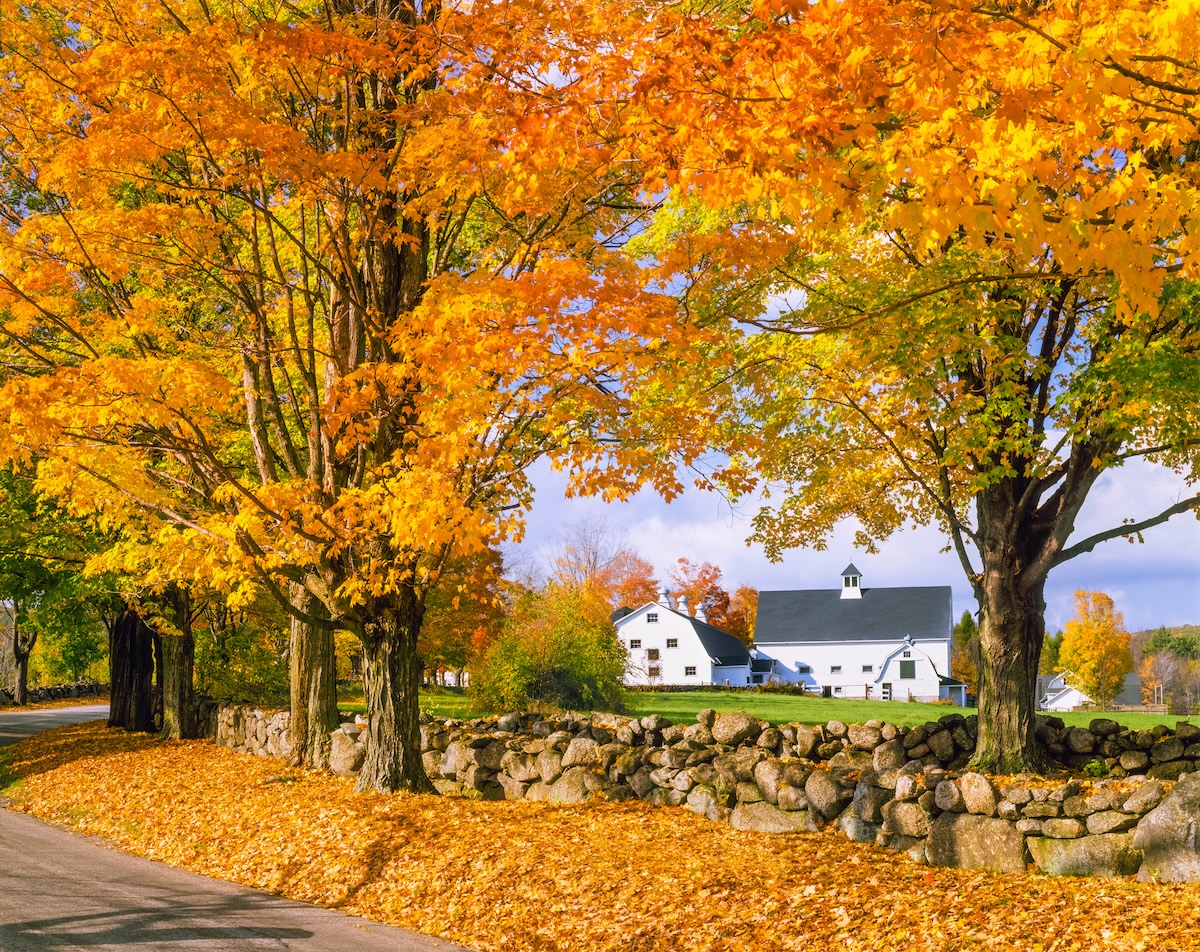
USDA hardiness zones: 3 to 8
Size: 60–75 feet tall; 40–50 feet wide
If you’re looking for backyard landscaping ideas that will add fall interest and color to your property, sugar maple is a great selection. The sugar maple tree’s spreading canopy puts on a vibrant show in autumn.
This tree thrives in sun or part shade, and will tolerate acidic or alkaline soil, as long as it is well-drained. Considered among the best shade trees for the backyard, the sugar maple can also serve as an ornamental tree. It’s no wonder this is an American favorite for the yard.
4. Silver Maple (Acer saccharinum)
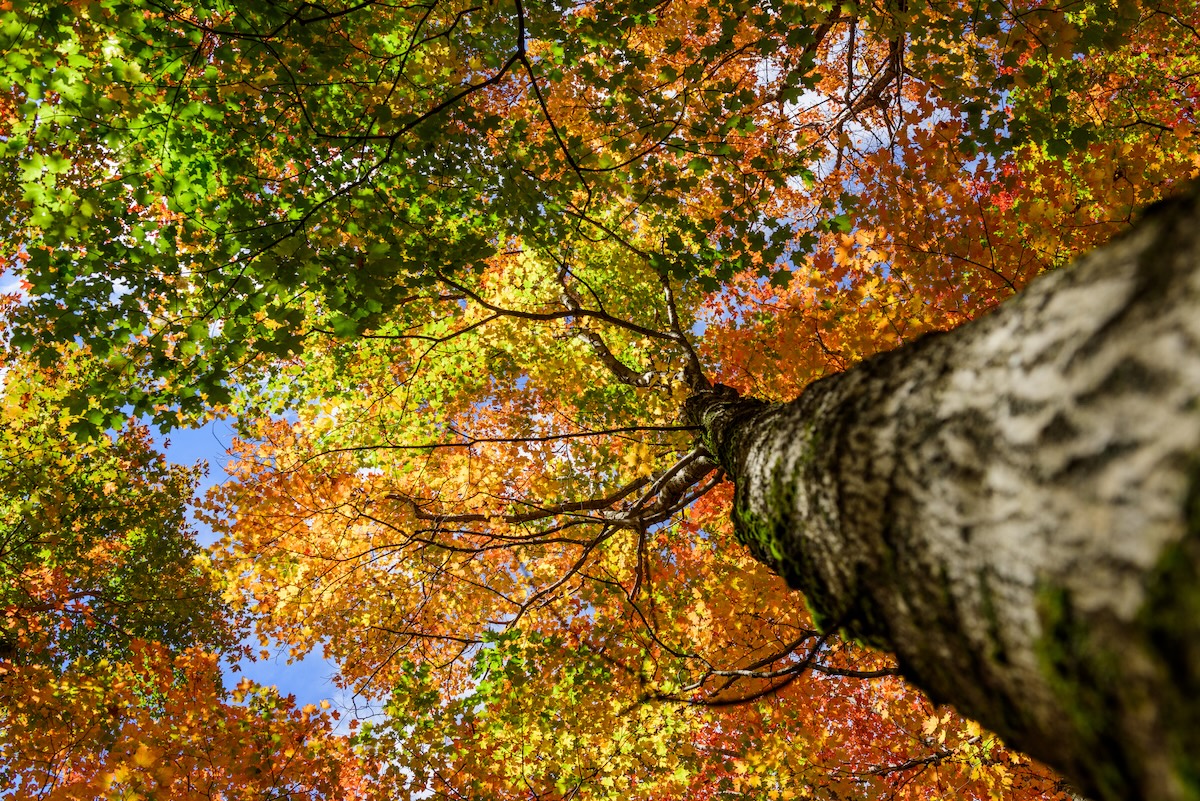
USDA hardiness zones: 3 to 9
Size: 50–70 feet tall; 30–50 feet wide
In as little as 5 years, the silver maple tree can transform your backyard into a shady retreat. The silver undersides of its leaves not only give the silver maple its name, but also lend the tree a shimmering silver appearance in the breeze.
Native to the eastern United States, this tree has a vast root system and large trunk, so be mindful to plant it away from sewer lines and walkways. Silver maple prefers moist or even wet soil, though it will tolerate moderate drought.
5. ‘Green Giant’ Arborvitae (Thuja ‘Green Giant’)
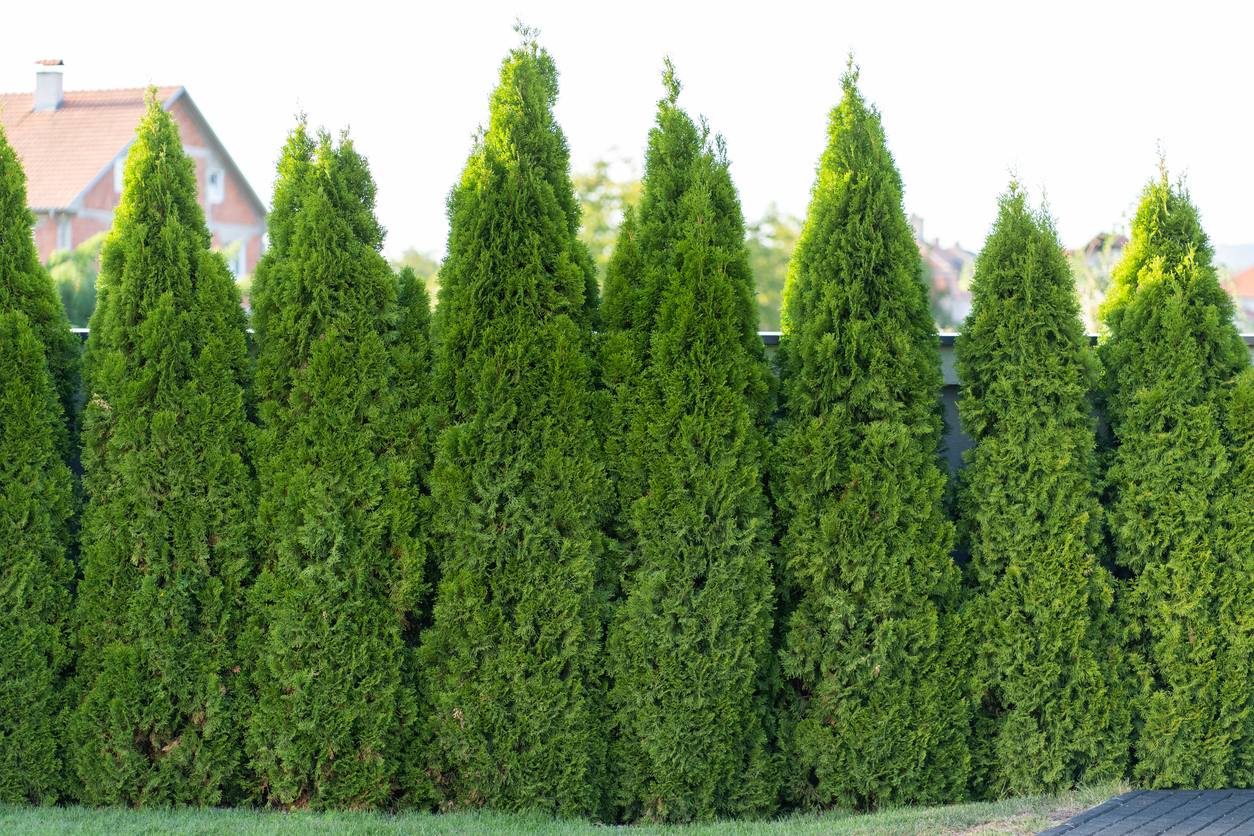
USDA hardiness zones: 5 to 8
Size: 40–60 feet tall; 12–18 feet wide
Backyard privacy is important in so many places, but it’s especially coveted between houses and yards in housing subdivisions. ‘Green Giant’ arborvitae is regarded as one of the best trees for backyard privacy. A fast-growing evergreen, it is exceptionally hardy, tolerates almost any soil—as long as it is moist—and has a beautiful conical shape. It thrives in full sun, but will tolerate afternoon shade. It’s great for a hedge, a screen, or as a single specimen in the backyard.
6. Weeping Cherry (Prunus pendula)
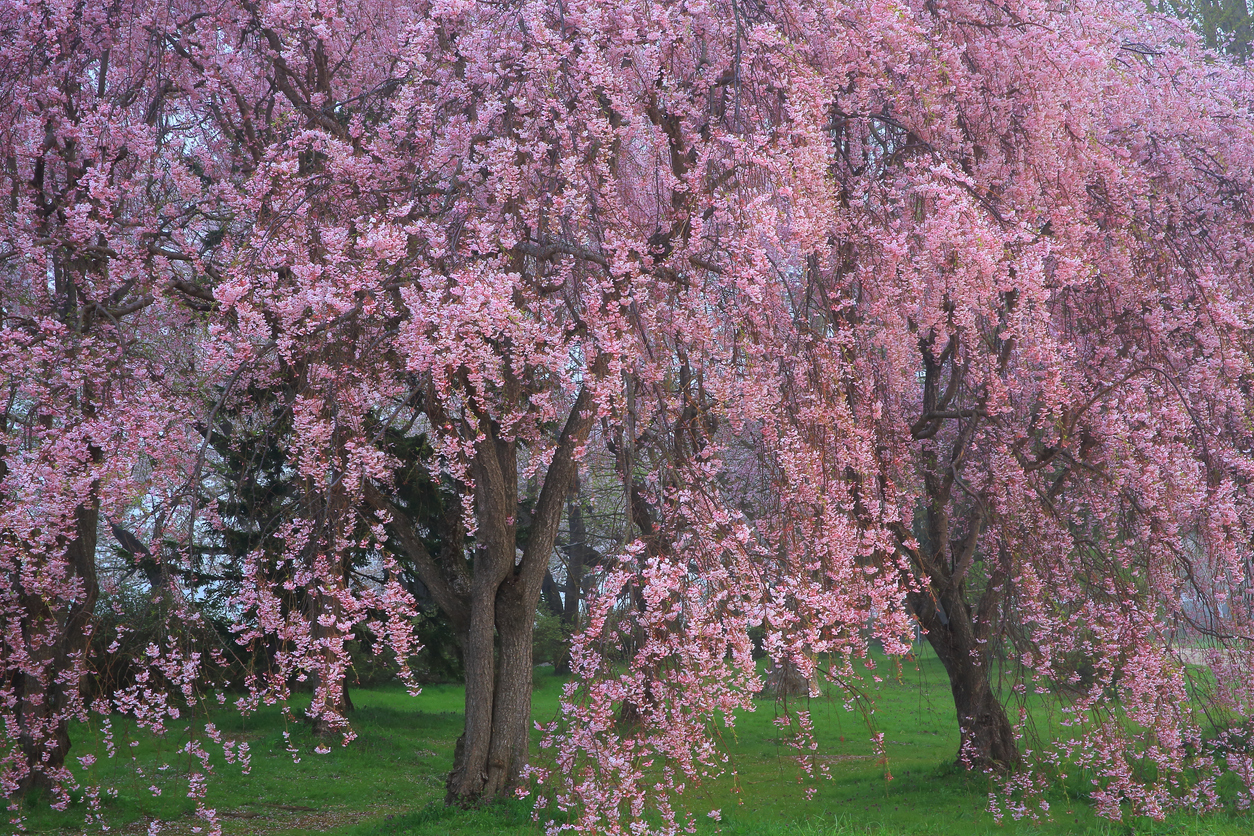
USDA hardiness zones: 6 to 8
Size: 20–30 feet tall; 20–25 feet wide
Few trees are as romantic and elegant as the weeping cherry. With cascading branches festooned with white or pink blossoms in spring, this graceful tree may quickly become the highlight of any backyard.
Plant weeping cherry in fertile, well-drained soil that is slightly acidic. It will do well in full sun or partial shade. This tree needs consistent moisture, but don’t overwater it. Its leaves, stems, and seeds are toxic to dogs, cats, and horses, and can cause gastrointestinal distress in humans, too.
7. Red Oak (Quercus rubra)
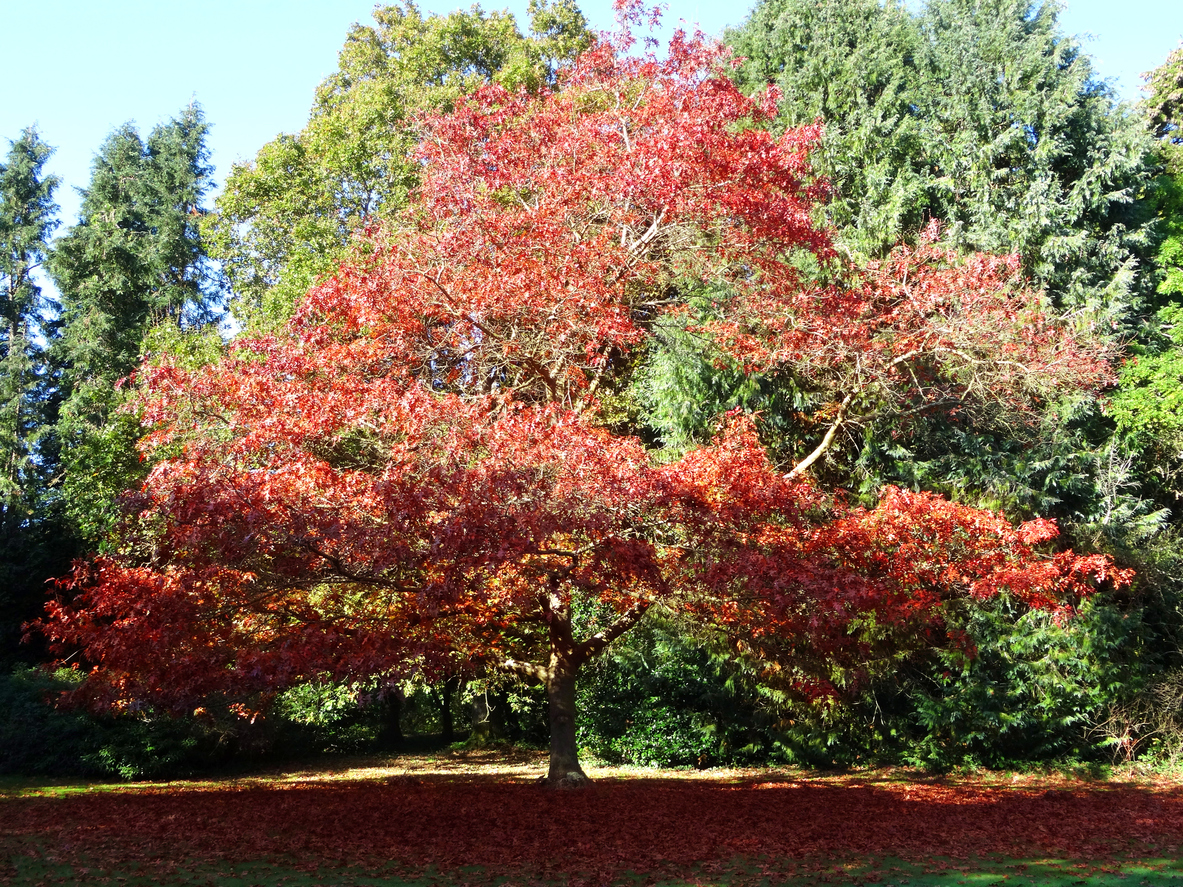
USDA hardiness zones: 4 to 9
Size: 60–100 feet tall; 50–75 feet wide
The red oak gets its name from the brilliant foliage it shows in fall. Popular for both its hardiness and beauty, it’s also one of our favorite fast-growing trees. Red oak has a dense, rounded canopy that offers excellent shade in large backyards.
This type of oak tree attracts birds and mammals to the yard, and is highly resistant to pests and diseases. Native to the Midwest, red oak prefers moist, acidic soils. Once established, this tree is moderately drought-tolerant but appreciates an occasional deep watering during dry periods.
8. American Holly (Ilex opaca)
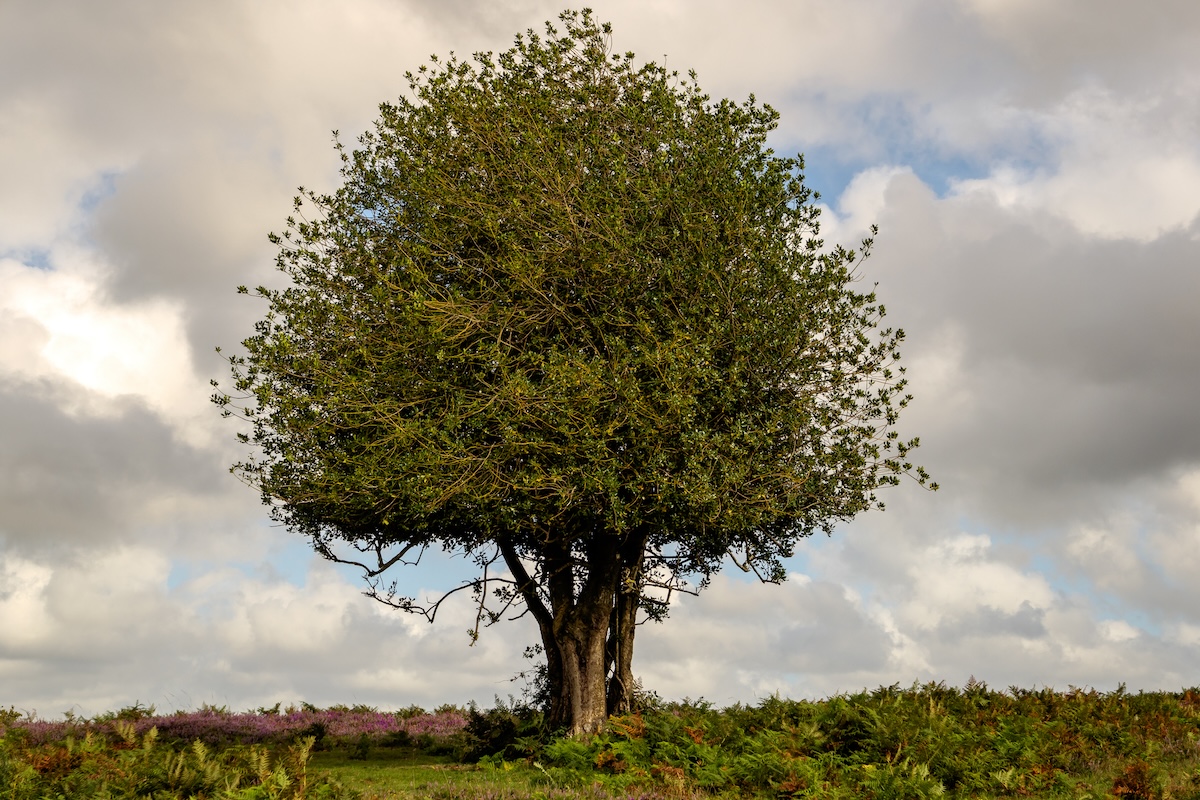
USDA hardiness zones: 5 to 9
Size: 15–25 feet tall, though it can grow taller in moist regions; 10–20 feet wide
Whether you’re looking for evergreen privacy trees for your yard or you just want to enhance your property with a singular ornamental stunner, American holly delivers. Small, white springtime blooms give way to red berries (actually drupes) in the fall, which remain throughout winter.
Holly plants offer both visual interest and food for wildlife, attracting birds and other small creatures to your yard. Plant it in full sun or in an area that gets a bit of afternoon shade. Put it in a spot that is protected from wind, and where the soil is generally moist.
9. Eastern Redbud (Cercis canadensis)
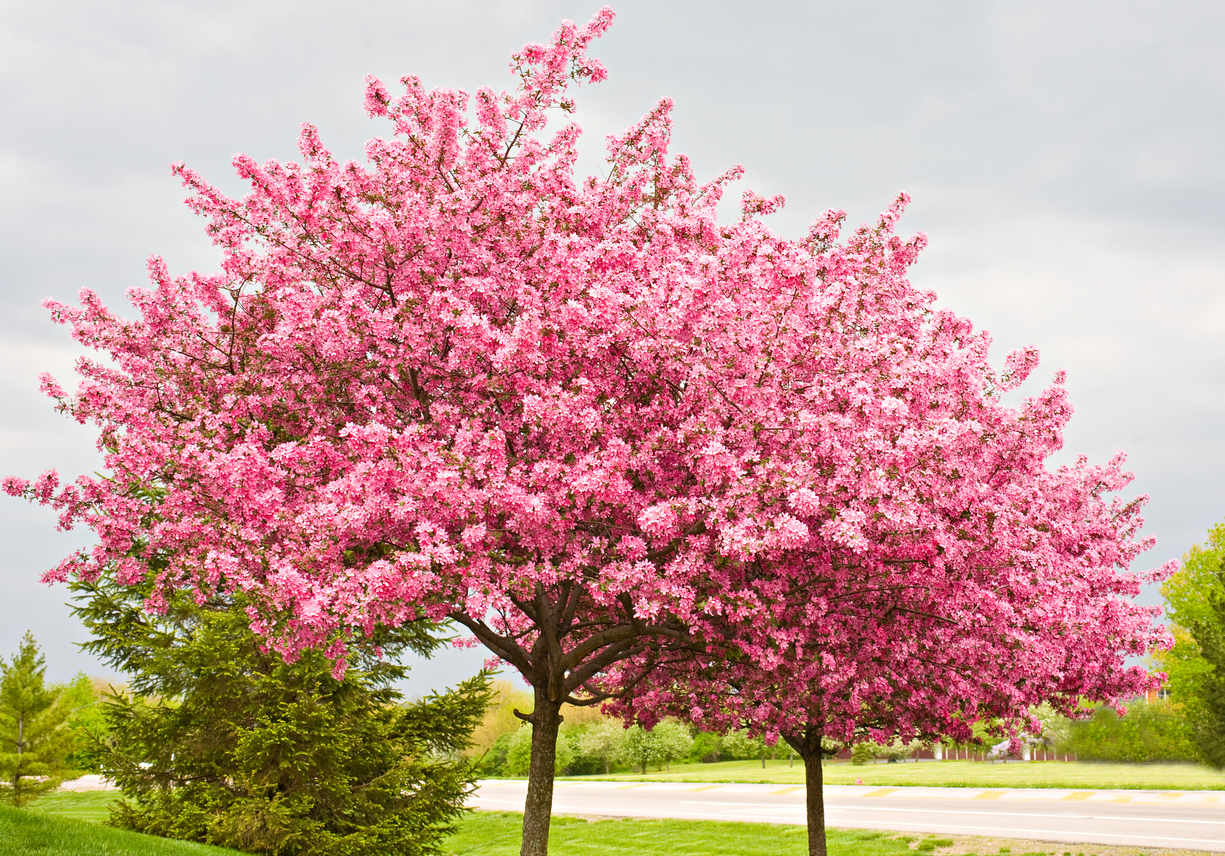
USDA hardiness zones: 4 to 9
Size: 20–30 feet tall; 25–35 feet wide
One of the first signs of spring is the brilliant purplish-pink blooming of the eastern redbud, but its attractive branching pattern makes this deciduous tree just as beautiful in winter as it is during the rest of the year.
This flowering tree likes moist, well-drained soil and it will best flourish if planted in full sun. It’s not picky about soil type or pH and will tolerate sandy and clay soils. Its soil, however, should be consistently moist. It doesn’t like temperatures more than 85 degrees Fahrenheit.
10. Tulip Tree (Liriodendron tulipifera)
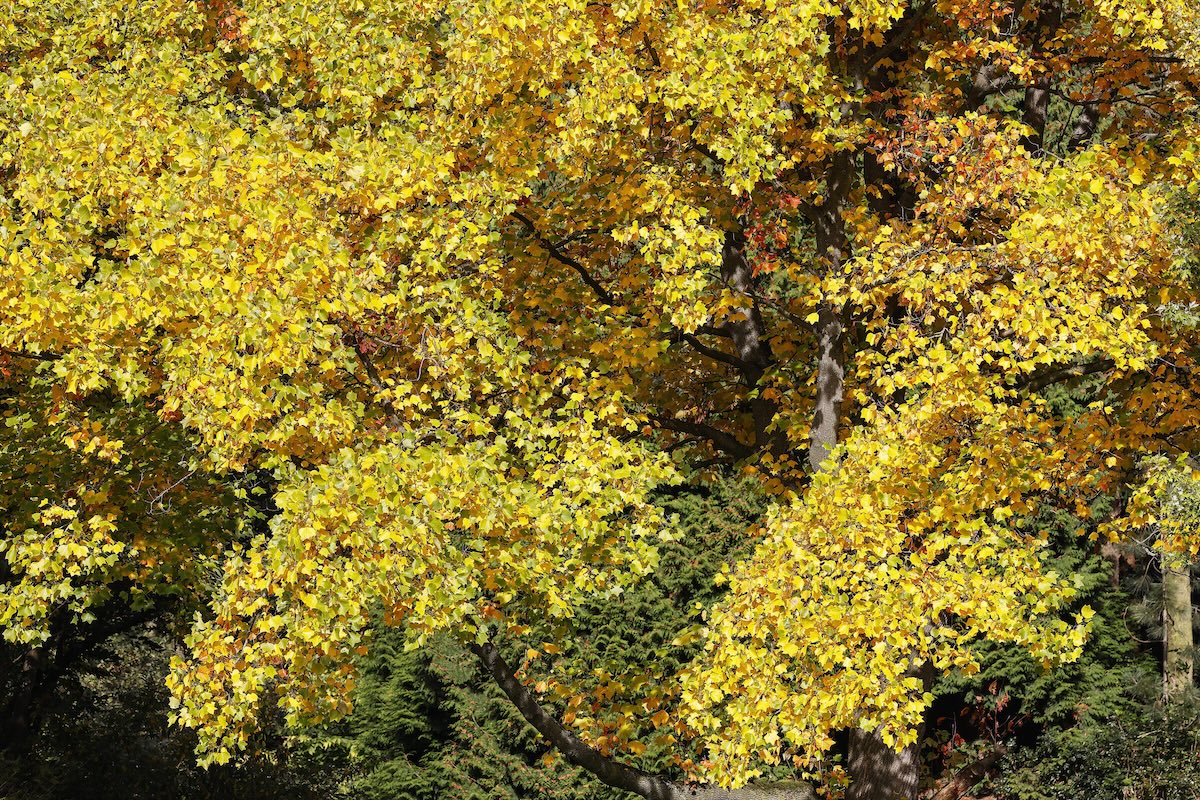
USDA hardiness zones: 4 to 9
Size: 60–150 feet tall; 30–60 feet wide
The tulip tree, liriodendron tulipifera, does double-duty as a shade tree and as an ornamental. It is bursting with showy tulip-shaped flowers in springtime and flaunts brilliant yellow leaves in the fall.
One of our favorite fast-growing shade trees, the hardwood tulip tree can grow more than 2 feet during a year. It has few pest problems, making it an ideal choice for big backyards where there is moist, acidic soil that drains well.
11. Paper Birch (Betula papyrifera)
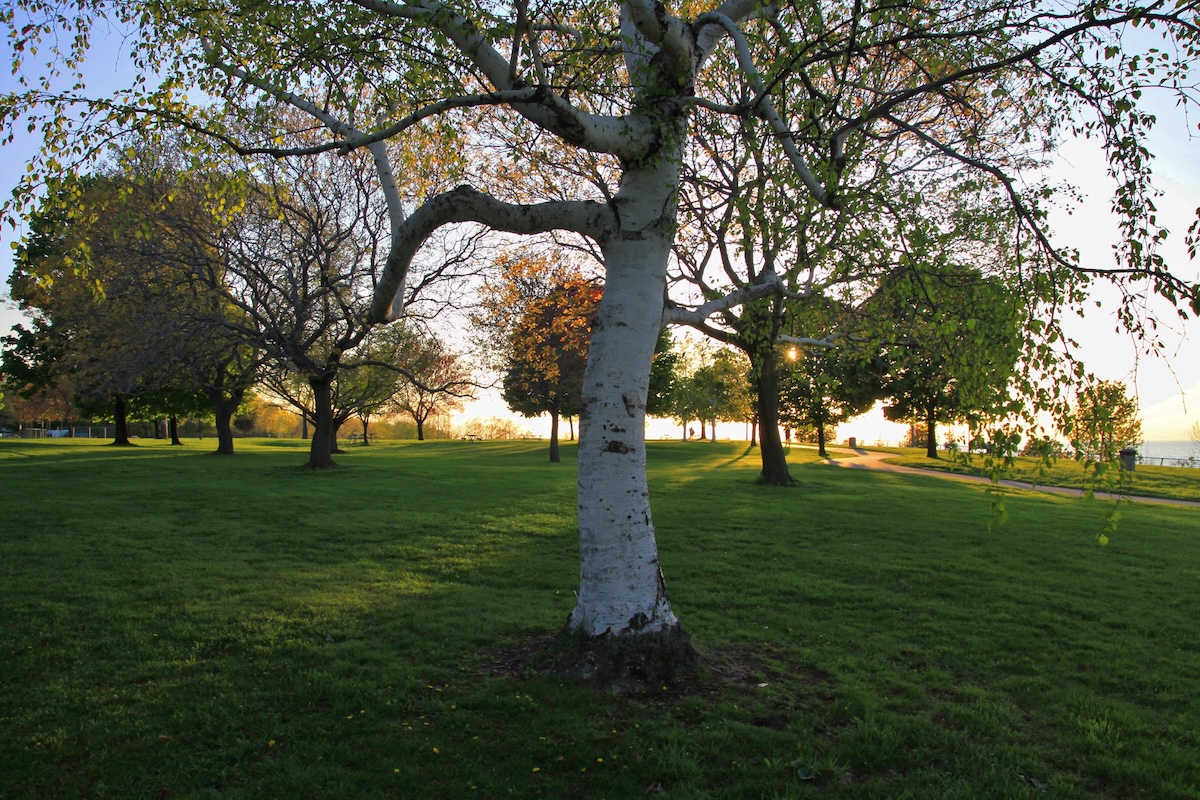
USDA hardiness zones: 2 to 7
Size: 50–70 feet tall; 25–50 feet wide
If you are looking for a tree that will quickly make an impression, consider the paper birch. The tall and lean tree is a fast grower that likes moist conditions; it does particularly well in partial shade.
Its green leaves turn golden yellow in the fall, which creates a lovely contrast with its white, peeling bark. Native to northern North America, the paper birch prefers long winters and moderate summers.
12. Crabapple (Malus)
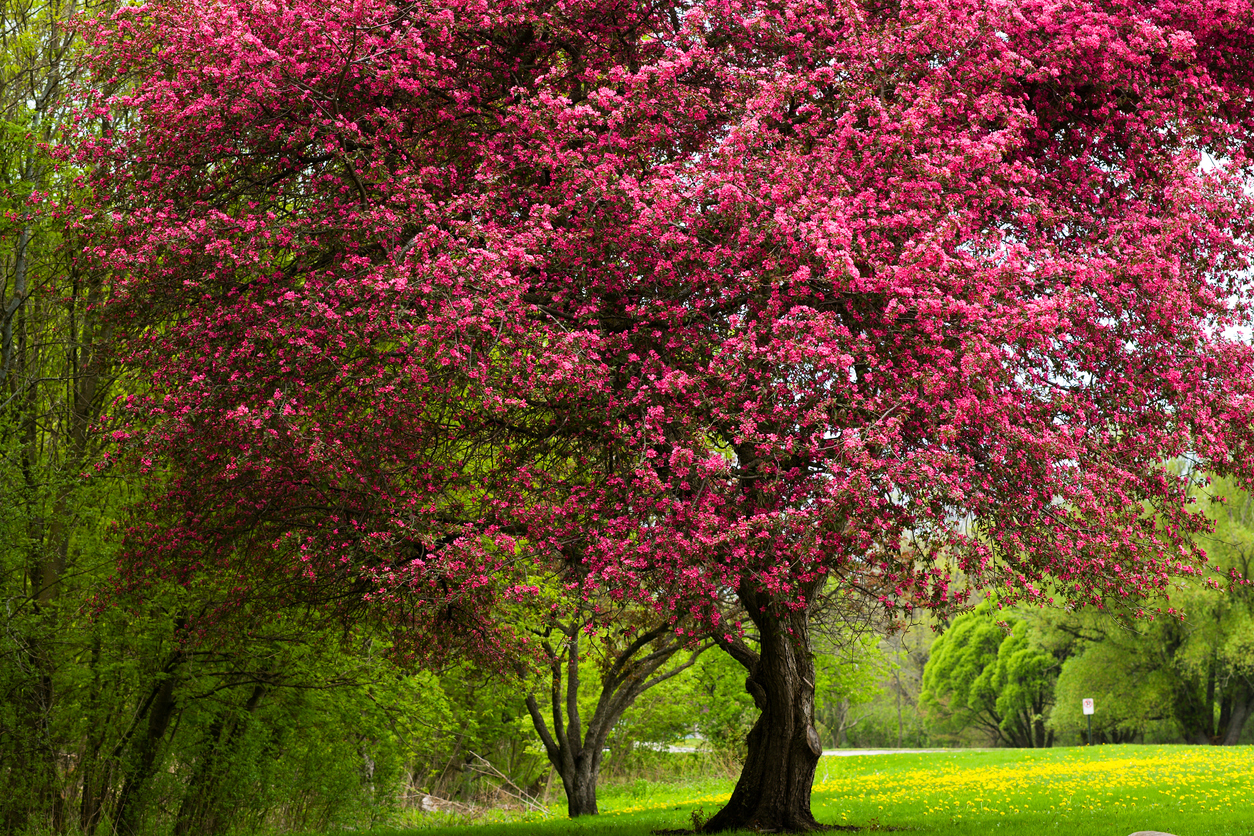
USDA hardiness zones: 4 to 9
Size: 10–40 feet tall and wide
Enjoy the colors of a crabapple tree practically year round when you pick the right variety for your area. There are more than 50 types to consider. In spring, crabapples sprout flowers that bloom in shades of white, pink, or red, depending on the variety.
Grow crabapple in full sun with moist, well-drained soil. At the end of summer, small apples start appearing, and they’ll last into winter even after the tree’s vibrant red and orange leaves fall off the tree. These trees can be a bit messy when their fruit drops.
13. Fringe Tree (Chionanthus virginicus)
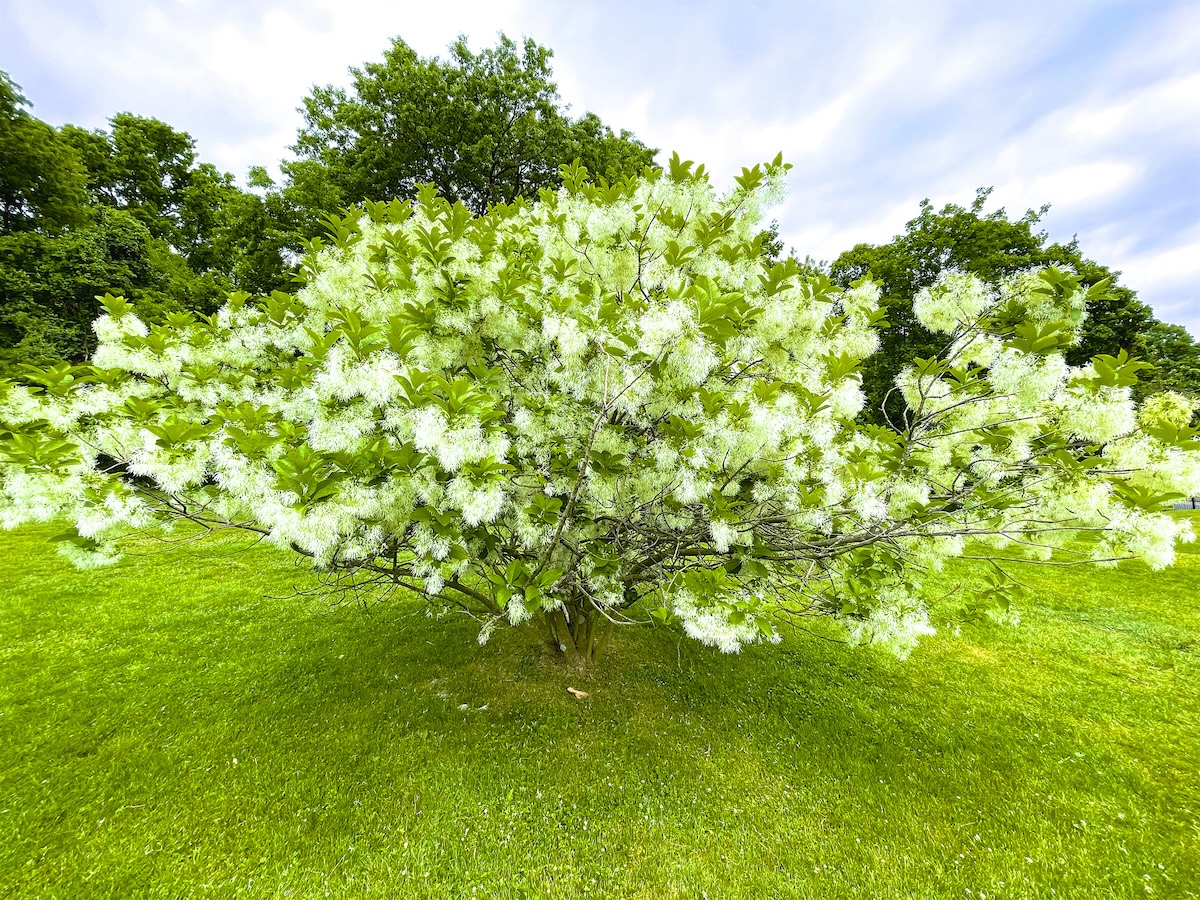
USDA hardiness zones: 3 to 9
Size: 12–20 feet tall and wide
The fringe tree makes a showy appearance in early spring with its namesake fringey, feathery white flowers that feature slender, 4- to 6-inch-long petals that droop gracefully.
While delicate-looking, the fringe tree is tolerant to pollution, which makes it a great pick if you live in a city or high-traffic area. And it’s a bit smaller than some of our other selections, and ranks among the best trees for small backyards. It prefers moist, fertile soils and full sun or part shade.
14. Washington Hawthorn (Crataegus phaenopyrum)
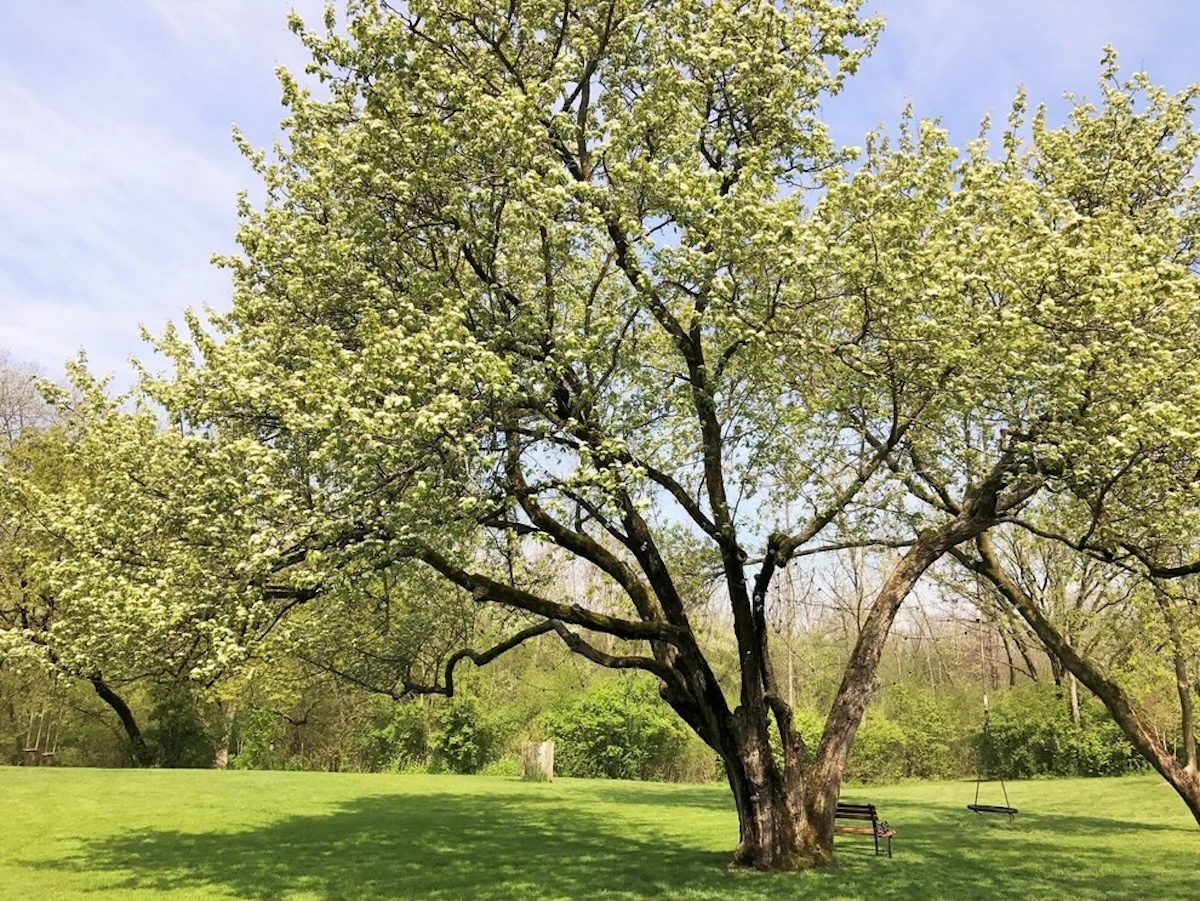
USDA hardiness zones: 4 to 8
Size: 25–30 feet tall and wide
If you want to attract birds and butterflies to your yard, consider planting a Washington hawthorn. This smaller deciduous tree has fragrant flowers in late spring and summer and produces small red fruit from summer through winter that draw in the wildlife. It also offers gorgeous foliage in the fall.
It will grow in a variety of soil types—loam, clay, and sand— if the soil is well-drained. It’s also not too picky about soil pH. Washington hawthorn is moderately drought-tolerant once established. However, its branches sprout long, spiky thorns that might not be good for yards where children play.
15. Serviceberry (Amelanchier)
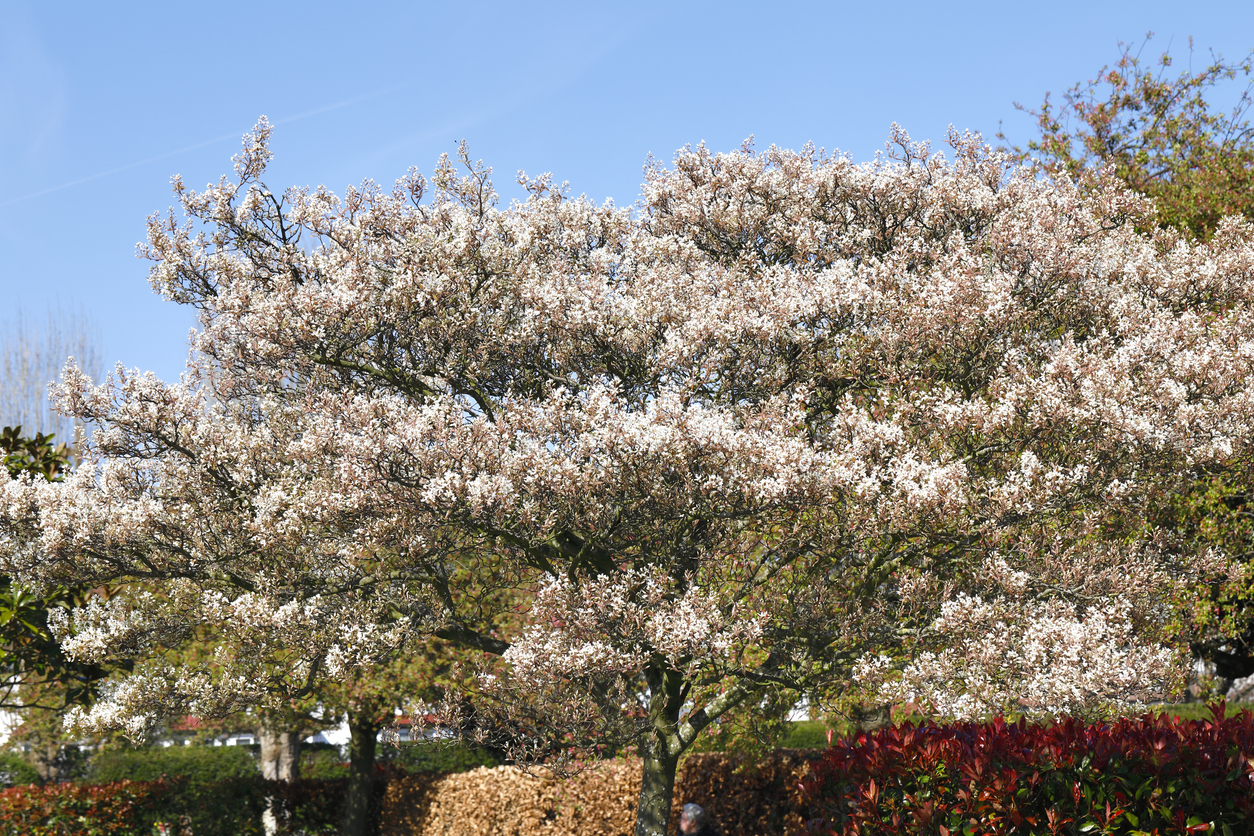
USDA hardiness zones: 2 to 9
Size: 15–25 feet tall and wide
Serviceberry, or shadbush, is a small native tree that looks great in a landscape for every season. This will be one of the first trees in your yard to flower in early spring, and then fruit berries in summer. In the fall, you’ll get to enjoy bright red and orange leaves.
Shadbush is tolerant of many growing conditions. It’s not picky about soil, but it does need at least 6 hours of full sun a day. Choose a variety—there are more than 30—that is native to your region to have the most success.
16. Catalpa (Catalpa)
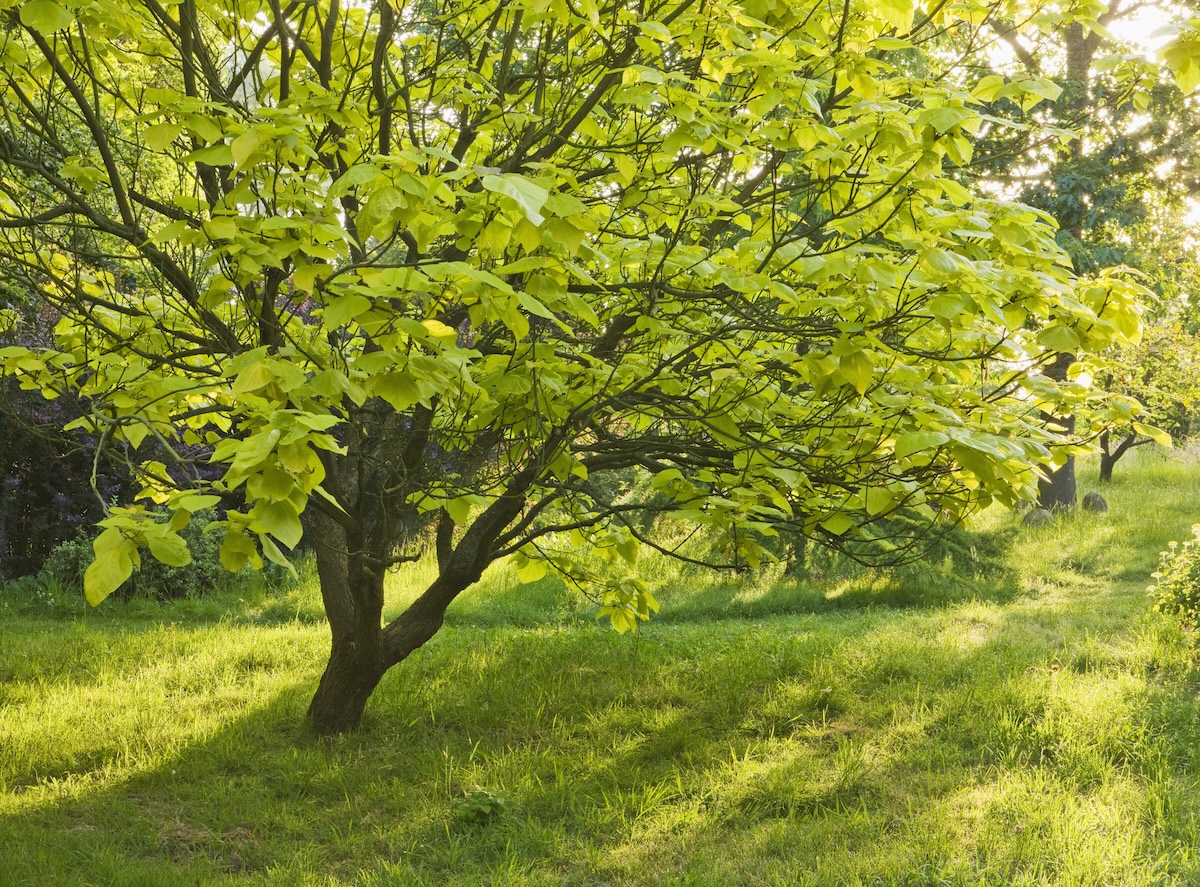
USDA hardiness zones: The northern species does well in zones 4 to 8, while the southern does well in 5 to 9.
Size: The northern type gets 60–90 feet tall and 40 feet wide. The southern type grows to 30–40 feet tall and wide.
Gardeners will find two catalpa species that are native to North America: southern catalpa (Catalpa bignonioides) and northern catalpa (Catalpa speciosa). Both trees produce pretty flowers in spring and summer; the northern types are larger, but the southern tree is more profuse.
Depending on where you live, either tree could make an excellent addition to the landscape. Both adapt to many soil conditions, tolerant of wet or dry soil and a range of pH. Catalpa, sometimes known as catawba, will grow in full sun or part shade. Both produce large seed pods that drop, creating a mess that some landscapers may find to be a hassle.
17. Fig (Ficus carica)
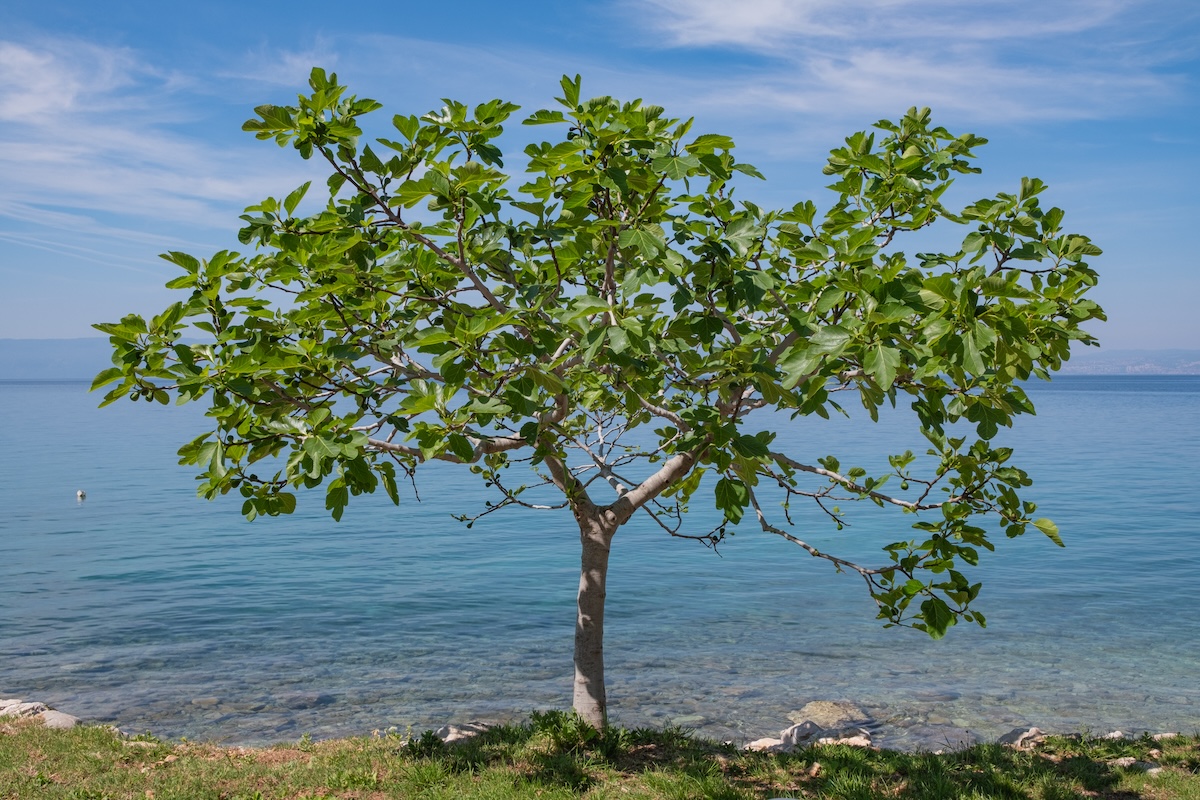
USDA hardiness zones: 7–12
Size: 10–30 feet tall and wide
Setting aside their tasty fruits for a minute, the large, gorgeous leaves of a fig tree are reason enough to plant this Mediterranean beauty. The deeply lobed leaves can be anywhere from 5 inches to 10 inches across, depending on variety. The large, mounding tree definitely makes a statement in the yard. And the fruit! It’s delicious right off the tree or baked into desserts.
Fig trees need long, hot summers, and they need full sun to flourish. They’re low-maintenance trees, and they’ll grow in pretty much any soil and, while they are drought-tolerant, they appreciate a drink during excessively dry periods.
18. Olive (Olea europaea)
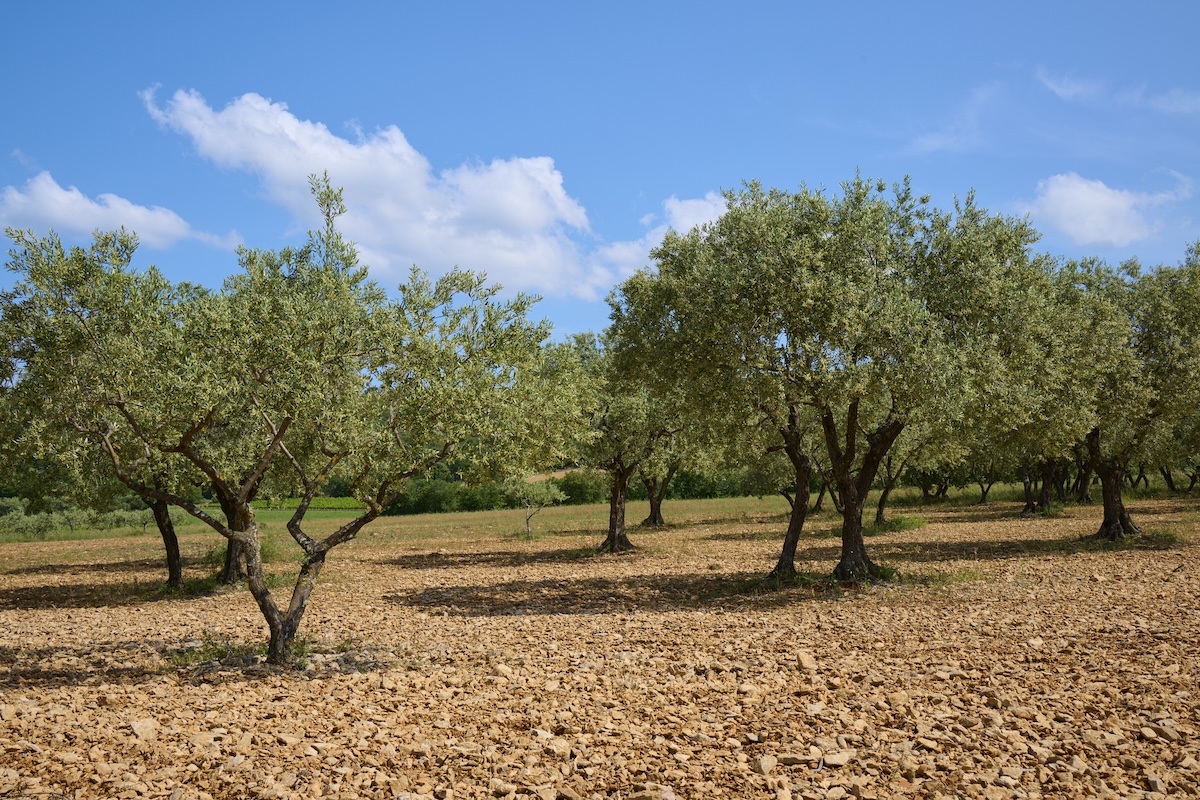
USDA Hardiness zones: 8 to 11
Size: 20–30 feet tall and wide
Olive trees’ beauty lies in their attractive silvery-green oval leaves, which glimmer in the sunlight. Additionally, as the trees age, their trunks become intriguingly gnarled and full of character.
Another gift from the Mediterranean, olive trees, too, need lengthy summers with plenty of sunshine and heat. Once established, they’re drought-tolerant, and when they’re about 3 years old, they’ll start producing fruit. If you don’t want to mess with collecting and processing the fruit, consider a non-fruiting variety to cut back on the mess.
19. Eastern White Pine (Pinus strobus)
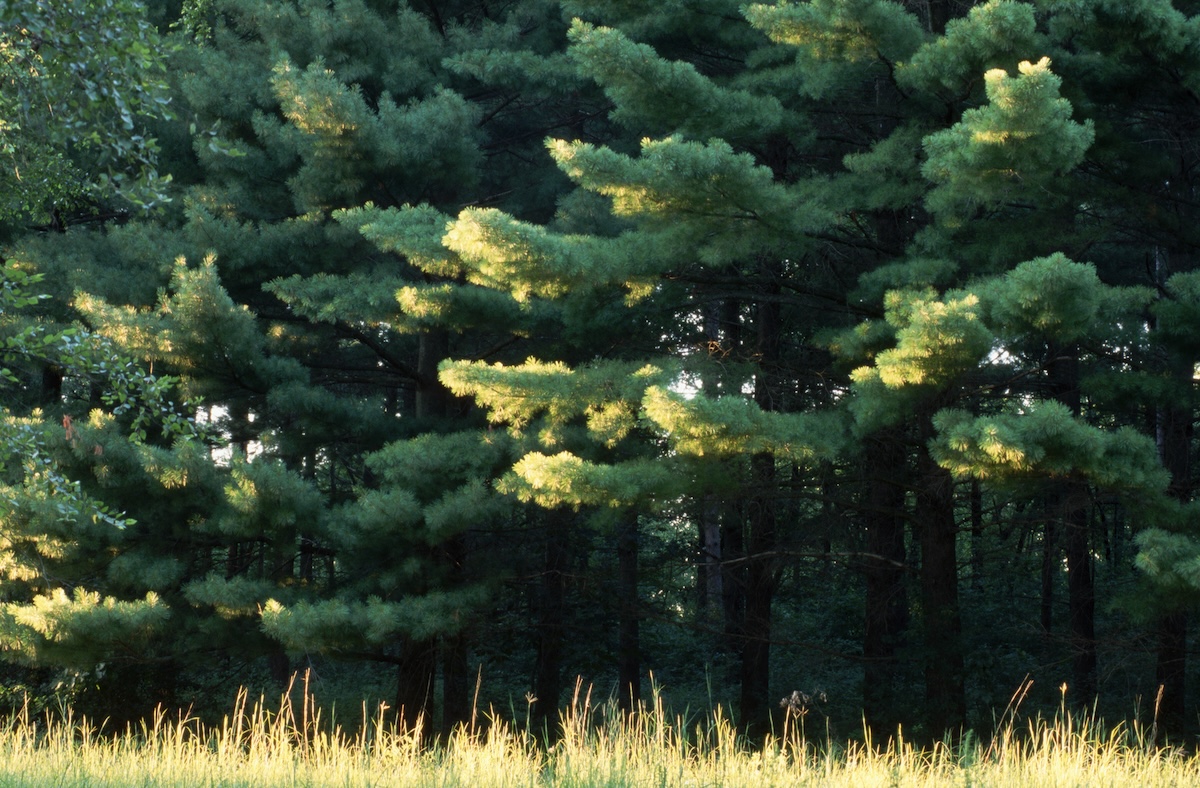
USDA hardiness zones: 3 to 8
Size: 50–80 feet tall; 20–40 feet wide
This fast-growing, long-lived tree is native to the northeastern United States and southeastern Canada. As a large evergreen tree, it makes a dramatic statement in the backyard landscape year ‘round. It’s a species often used as Christmas trees, so if year-round Christmas is your thing, you’d be set with this beauty in the backyard.
Plant this pretty pine in a spot with full sun in moist, fertile, well-drained soil that’s acidic and sandy or loamy. It’s intolerant of pollution, so this conifer is probably not best for urban settings.
20. Desert Willow (Chilopsis linearis)
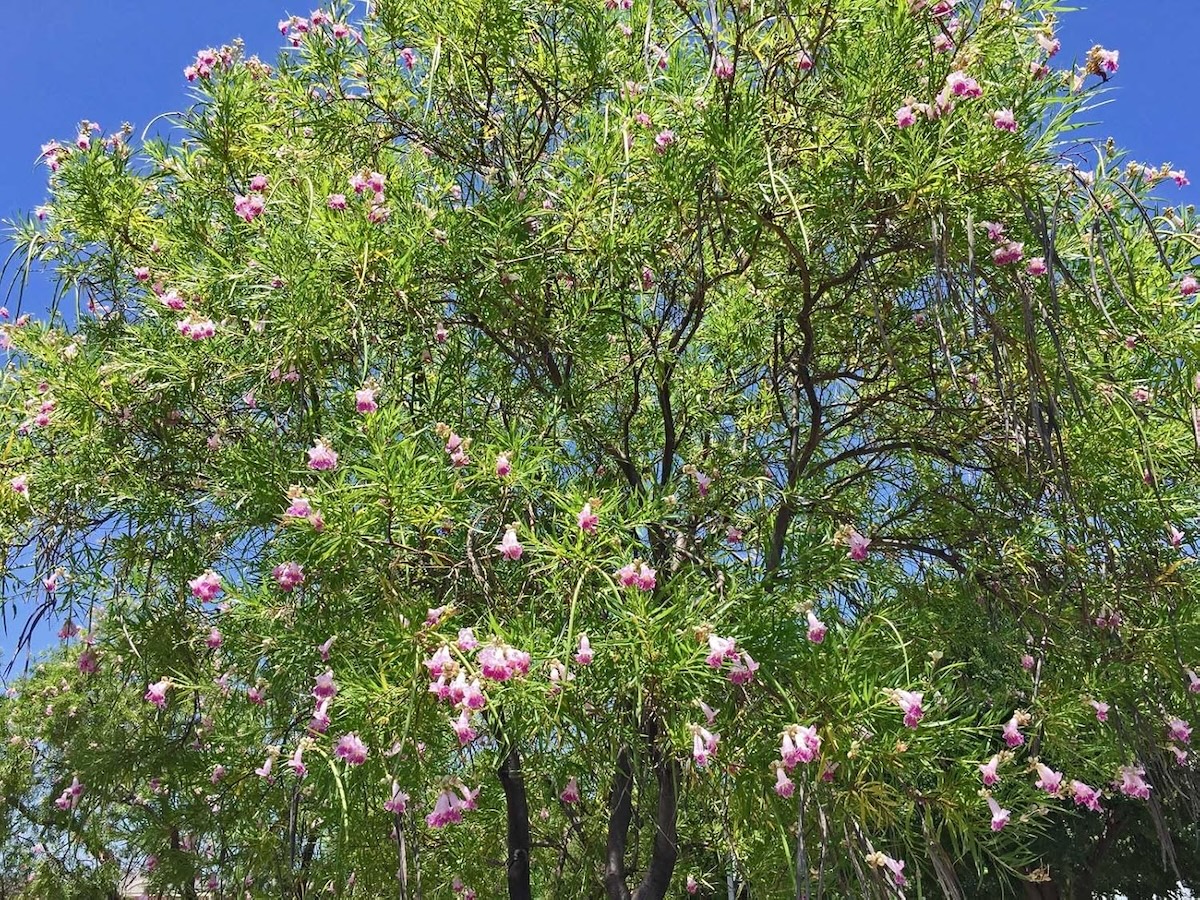
USDA hardiness zones: 7 to 11
Size: 15–30 feet tall; 10–20 feet wide
Native to the southwestern United States and northern Mexico, this elegant tree, which is actually not a true willow, bursts into bloom in early spring. Its showy pink flowers are trumpet-shaped, and its long, narrow leaves and loose, attractive form make it a standout in the desert landscape.
Unsurprisingly, desert willow likes long, hot summers and is drought-tolerant. However, it blooms more profusely throughout summer if it gets occasional irrigation. It usually grows at a moderate to fast rate. The deciduous tree sheds its leaves in late fall, but is quick to re-leaf in early spring. Between dropping flowers in spring and leaves in fall, it can make a bit of a mess, but since it’s a small tree, the mess isn’t overwhelming.
